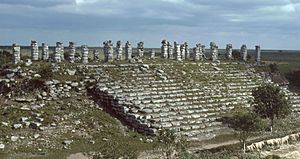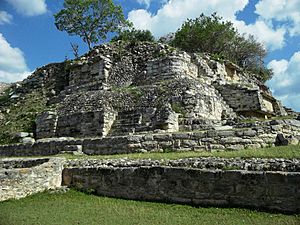Ake facts for kids
Aké (pronounced Ah-KAY) is an amazing ancient city built by the Maya civilization. It is an archaeological site in the Mexican state of Yucatán. You can find it about 40 kilometers (25 miles) east of the city of Mérida, Yucatán.
The name Aké comes from the Yucatec Maya language. It means "place of reeds." This name might tell us something about the plants that grew there long ago.
Contents
Discovering Aké: An Ancient Maya City
Aké is a special place where you can explore the ruins of an ancient Maya city. It shows us how the Maya people lived and built their homes. This site is a window into a powerful civilization.
When Was Aké Built?
The buildings at Aké are very old. They were built during the Early Classic period of Maya history. This time was between 250 and 550 AD. That means some parts of Aké are nearly 1,800 years old!
People first wrote about Aké in the 1840s. Two explorers, John Lloyd Stephens and Frederick Catherwood, described the ruins. They helped the world learn about this incredible site.
Unique Architecture of Aké
Aké has a very special building style. Many Maya pyramids are steep with small steps. But at Aké, the main building, called Structure One or "The Palace," is different.
The Palace: Structure One
Structure One is a huge platform with rows of stone columns on top. It has a gentle slope made of large, flat stone slabs. This unique way of building with giant stones is called "megalithic architecture." You can also see this style at other Maya sites like Izamal and Ek Balam.
Ancient Roads and Walls
Aké was connected to other Maya cities by special ancient roads. These roads are called sacbeo'ob (sak-BAY-oab). They were raised pathways that made travel easier. One sacbe even runs all the way from Aké to the city of Izamal.
The city of Aké was protected by two large circular walls. One wall marked the center of the city, which was about 4 square kilometers (1.5 square miles). The other wall protected the main living areas inside. The center of Aké is large and square. It is surrounded by tall buildings, some as high as 25 meters (82 feet).
Today, the ruins of Aké are found within a 19th-century farm called a Hacienda henequenera.
See also
 In Spanish: Aké para niños
In Spanish: Aké para niños



